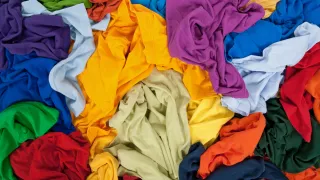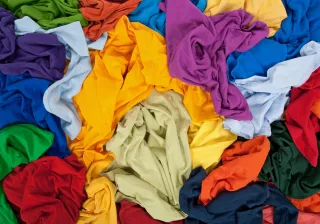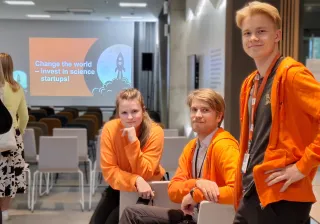The apparel industry has experienced radical transformations throughout the years. Thirty years ago trends and consumer demand were forecast long before consumers purchased the garments, and the production was planned and sized accordingly [1]. In the late 1980s, the industry developed a global infrastructure that emphasized quick response to consumer demand through reduced lead times and low costs. Fast fashion was born.
During the last 20 years, the price of clothing has fallen and the number of imported pieces of clothing has increased. In the US, apparel prices were on average 10% lower in 2005 than in 1998 [4]. Globally since the year 2000, the amount of clothing sold has doubled, and the number of times a garment is worn has decreased by 36% [5]. From 1975, the global production of textile fibers has increased by a staggering 280%. This is a 4-fold increase. The raw materials, such as cotton, are becoming scarce or unsustainable to produce.
We live in an era of ‘excessive accumulation’ of clothing [4]. As the closet space is finite, some of that excess has to be discarded. In Finland, people and organizations discard approximately 72 million kilograms of textile waste annually. This is 13 kg per citizen [2].
There is a problem to be solved. The solution is a circular economy of textiles.
In the Relooping Fashion project, a model was conceptualized based on the operations that a circular business ecosystem for textiles would include. The inner circle is about reviving old apparel maintenance skills and practices: repairing and reusing clothes and textiles. However, it is unclear if this truly decreases the consumption of virgin clothing and textiles.
If reuse of clothing is not possible, its material can be reused
The outer circles of the model include all the industrial processes and logistics required to recycle textile materials, either chemically or mechanically, to textile yarn, fabric and again to clothes. The overall goal is to maintain the value of materials as high as possible, with minimum environmental impact. VTT has innovated new processes through which textiles can be produced from wood or discarded cotton clothing.
As the circular textile economy model suggests, the way forward is, in theory, relatively straight. We know what the elements are. We have to create value from waste, emphasize functionality over ownership, and create sufficiency-based resource use [2].
Are these shifts already happening? Yes they are.
VTT is coordinating the Telaketju project, which aims to create a comprehensive collection, sorting and refining system for end-of-life textiles in Finland. There is considerable drive and enthusiasm in the group. Similar circular economy initiatives are being set up in most countries.
Is the shift happening fast and profoundly enough?
Is it possible to create a circular economy within the current linear economy? These are much more complicated questions.
The world has streamlined its linear production systems for decades. These processes rely on virgin raw materials. This is why it is important to intensively develop technologies to utilize recycled materials. However, technologies as such are not enough. Reorganization should happen at mental, structural and economic levels.
One of the main challenges is that value is not evenly divided in the current value chains, as discussed in [2]. Farmers and manufacturers bear the environmental and social costs in the form of toxic chemicals, inhuman working conditions, and lack of water, while the brand owners and consumers reap the profits and cheap garments.
Consumer demand is the momentum for change
The current idea is that consumers should start demanding that fashion brands take responsibility, and of course they should. Alongside consumer demand, there is also a large number of political and legislative tools, such as raising recycling targets, stringent waste legislation, labeling schemes on products, rules for public procurement and so on, which can be used to turn the ship.
However, all the above are partial solutions emerging from the current state of affairs. I believe that there should be a mechanism throughout the economy that would favor circularity over linear throughput. This in-bedded mechanism would drive the circular economy in the right direction. This is the place where we need profound innovation, as there are no working solutions yet.
Nonetheless, we have a firm intention, which is the first step of any transformation. The actions will follow.
LITERATURE:
[1] BHARDWAJ, V. & FAIRHURST, A., 2010, FAST FASHION: RESPONSE TO CHANGES IN THE FASHION INDUSTRY. THE INTERNATIONAL REVIEW OF RETAIL, DISTRIBUTION AND CONSUMER RESEARCH, 20(1).
[2] FONTELL AND HEIKKILÄ, 2017, MODEL FOR CIRCULAR BUSINESS ECOSYSTEM FOR TEXTILES, VTT TECHNOLOGY 313.
[3] STATISTA, HTTPS://WWW.STATISTA.COM/STATISTICS/263154/WORLDWIDE-PRODUCTION-VOLUME-OF-TEXTILE-FIBERS-SINCE-1975/
[4] SCHOR, J.B, 2005, PRICES AND QUANTITIES: UNSUSTAINABLE CONSUMPTION AND THE GLOBAL ECONOMY, ECOLOGICAL ECONOMICS, 55(3), 309-320.
[5] ELLEN MACARTHUR FOUNDATION, 2017, A NEW TEXTILES ECONOMY: REDESIGNING FASHION’S FUTURE, PP, 150.






